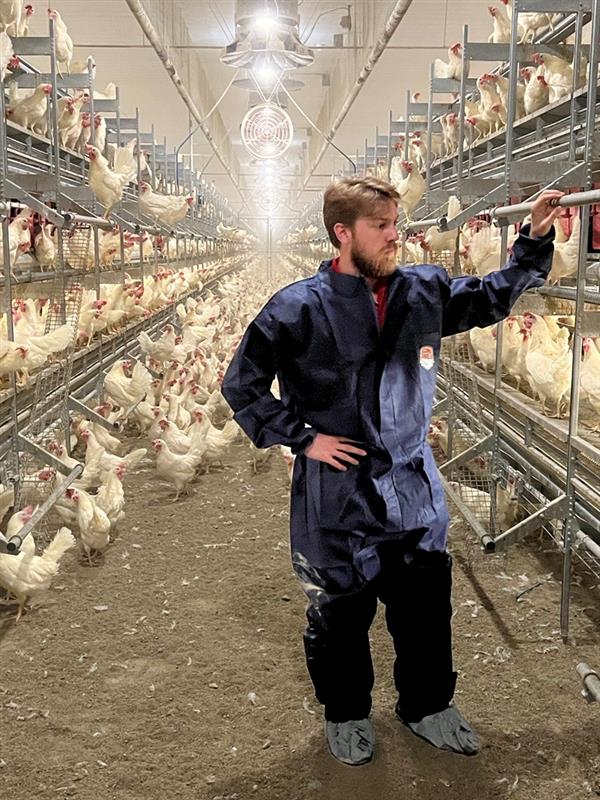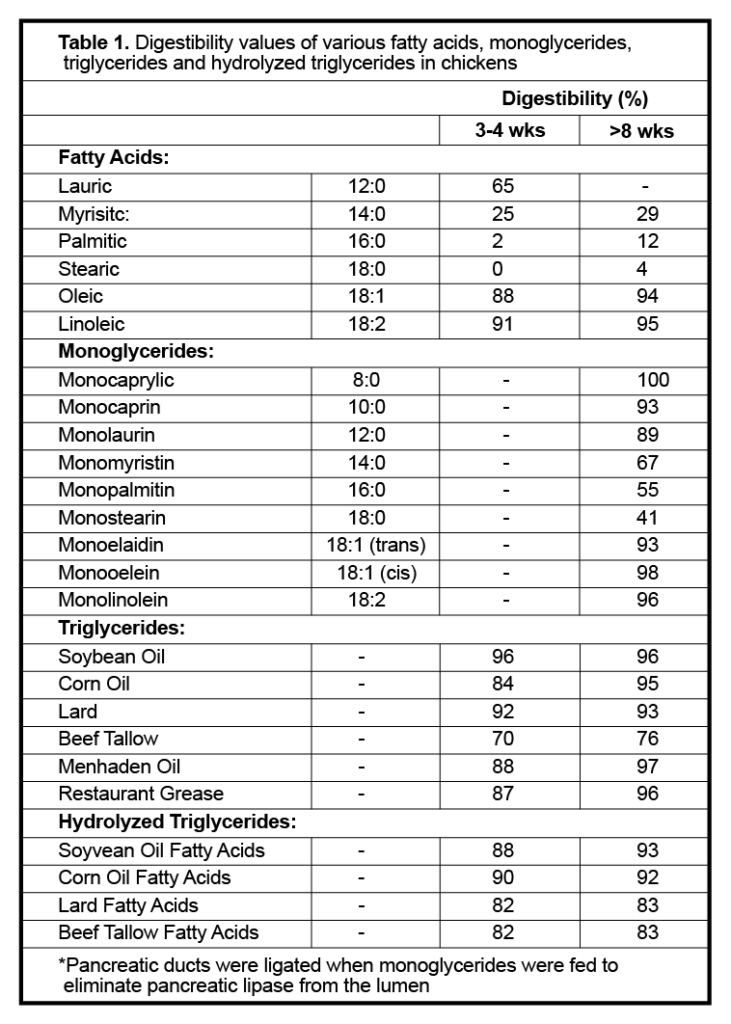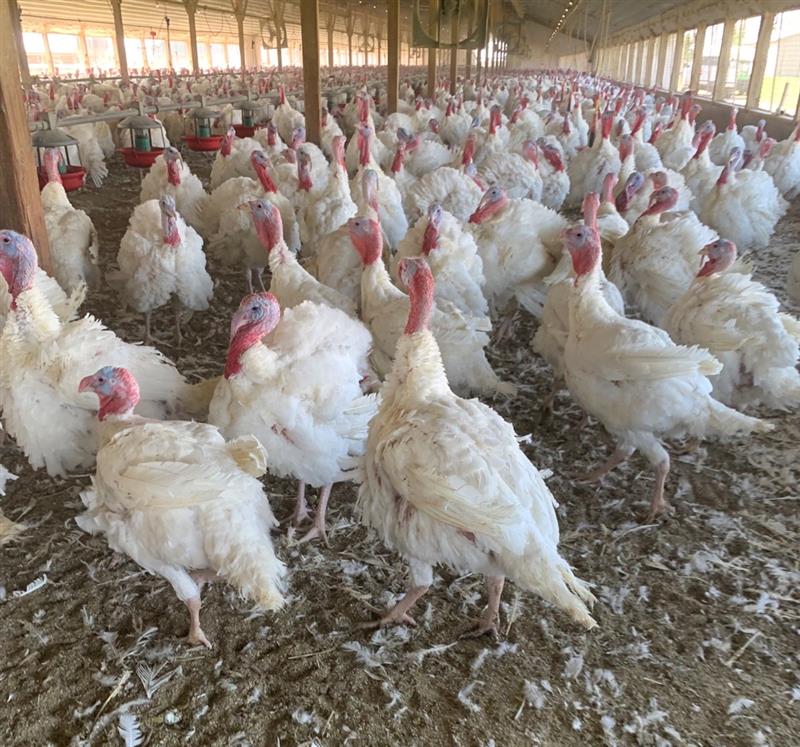By Ky Meeks, Ph.D.
Dietary fats are crucial for poultry diets, yet all fats are not equal. They offer high energy density and essential nutrients. The discussion covers differences in fat sources, factors affecting fat digestibility, synergism between sources, and the need for utilization of antioxidants and fat digestion supplements to lower feed costs.
KEY TAKEAWAYS:
- Fat ingredients have the highest caloric density of feedstuffs.
- Fats are used in diets for more than just energy, including improving dust control, palability, and flowability.
- The ratio of Unsaturated:Saturated fats in a poultry diet is important for optimal digestibility, as poultry see best performance with high levels of unsaturated fats.
- Fats can render an “extra-caloric effect,” improving digestion of other nutrients.
- Supplementing antioxidants and fat digestion supplements can improve fat sources.
Lipids in animal diets are generally referred to as “fats,” and dietary sources of fats, i.e., animal fats and plant/seed oils, contain the highest caloric density of all dietary nutrients. Nutritionally, it is very advantageous to add fats into poultry diets as they can elevate the energy level in a diet through a low inclusion rate. It is also preferable to add fats into poultry diets from an economical perspective, as their low inclusion rates can reduce the need for other expensive carbohydrate and protein ingredients. As reviewed (Ravindran et al., 2016), additional benefits of adding fats into poultry diets include reduced dustiness of feed, lower particle separation in mash diets, improved palatability, carriers for fat-soluble vitamins, supply of essential fatty acids, improved flowability of feed through feed milling equipment, and a phenomenon known as the “extra-caloric effect” of fats in which fat reduces the passage rate of feed through the digestive tract, allowing more time for digestion and absorption of nutrients. While the usage of fats has clear benefits in poultry diets, all fat sources are not created equal and thus will be differentiated in this article.

Dietary fats are concentrated sources of triglycerides of variable fatty acid profiles, which can confer the high energy makeup of these ingredients. However, the energy of fat sources for poultry can vary greatly based on the digestibility of the fats. Fat digestibility has been described (Leeson and Summers, 2001) as being influenced by: (1) The chain length of the fatty acids; (2) the number of double bonds in the fatty acid; (3) the presence or absence of ester linkages, or whether the fat is in the form of triglyceride or as a free fatty acid; (4) the specific arrangement of the saturated and unsaturated fatty acids on the glycerol moiety of a triglyceride molecule; (5) age of the chicken; (6) the ratio of unsaturated to saturated fatty acids in the mixture of free fatty acids; (7) the intestinal microflora; (8) the composition of the diet in which the fatty acids are fed; and (9) the amount and type of triglycerides in the dietary fat mixture. Fatty acids are chains of carbon, with hydrogen atoms along the length of the chain and a carboxyl group at the end. As a rule of thumb, the longer the fatty acid chain, the lower its digestibility for the animal as shown in Table 1 (Leeson and Summers, 2001). However, the unsaturation of a fatty acid, or the presence of double bonds along the carbon chain, greatly increases the digestibility of the fatty acid. For example, stearic acid is an 18-carbon saturated fatty acid, meaning it has no double bonds, found in high concentrations in beef tallow and has a low digestibility for poultry. On the other hand, linoleic acid is an 18-carbon unsaturated fatty acid with 2 double bonds and is not only highly digestible at over 90% but is also essential for poultry. Due to having a higher digestibility, linoleic acid has a higher energy value than stearic acid for poultry. The optimal ratio of unsaturated: saturated for fat digestibility and metabolizable energy has been determined to be 4:1 in poultry (Ketels and De Groote, 1989). However, this research found no stark benefit above a ratio of 2:1, therefore a compromise of 3:1 unsaturated: saturated has been established as an effective ratio for optimal fat digestibility in poultry diets (Leeson and Summers, 2009). Feeding highly unsaturated fat sources, in comparison to highly saturated fat sources, improve production in laying hens (Gao et al., 2021), and growth performance of broilers (Baião and Lara, 2005) and turkeys (Leeson and Atteh, 1995). Fat sources that contain high levels of saturated fats include beef tallow, lard, coconut oil, and palm oil. Fat sources that contain high levels of unsaturated fats include corn oil, soy oil, most other vegetable oils, and fish oils.

While dietary fats are primarily sources of triglycerides, there are also small proportions of free fatty acids in these ingredients. It has been demonstrated there is a negative correlation between free fatty acid levels in the diet and metabolizable energy for poultry, with the negative effect being more pronounced in saturated fats (Sklan, 1979). Consequently, the level of free fatty acids is considered a sign of rancidity. While high levels of free fatty acids should always be avoided, the reduction in metabolizable energy from free fatty acids appears to be more severe in diets containing highly saturated fat sources compared to diets containing highly unsaturated fat sources (Wiseman and Salvador, 1991). Another factor relating to fat quality is the level of oxidation and rancidity that has occurred in the fat source. Oxidation is a degradation process of the glyceride structure, producing unstable peroxide free radicals that accelerate the degradation process into products that give off the “rancid” odor, leading to a loss in energy and potential loss of viability of fat-soluble vitamins in the diet (Leeson and Summers, 2009). Including high levels of antioxidants in the diet can drastically reduce the occurrence of oxidation and rancidity. To ensure a diet contains an optimal fat source, careful consideration should be taken to purchase high quality fat sources with low levels of free fatty acids, and high levels of antioxidants should be included in the diet.
The age of poultry has a significant impact on the digestibility of fat sources and, therefore, their energy value. Research has shown that older birds have a better ability to utilize fat sources for energy than young birds, as newly hatched chicks have limited secretion of bile, lipase, and fatty-acid binding protein (Krogdahl, 1985). The impact of age on fat digestibility can be dependent on the fat source. Poults (Whitehead and Fisher, 1975; Sell et al., 1986) and chicks (Renner and Hill, 1960; Wiseman and Salvador, 1989) two weeks and younger have been found only to utilize between 50-70% of highly saturated fat sources, while highly unsaturated fat sources can typically be utilized between 80-95% at this age, with utilization of both groups improving with age. Due to this, plant oils such as corn and soybean oil have been typical fats used for young birds. As birds age, their ability to utilize fats increases, hence the elevated levels of fats in the diets of older birds. It is common to see animal fats mixed into fat sources as birds age due to their reduced costs, as well as a synergism that appears to occur between unsaturated and saturated fats (Ketels and De Groote, 1989).
Intestinal microflora and intestinal health also play a role in fat digestibility. Broilers infected with coccidiosis have been found to exhibit severely reduced fat digestibility, with a 96% reduction in apparent ileal fat digestibility (Amerah and Ravindran, 2015). Mycotoxins have a negative impact on fat utilization, mainly through peroxidation in the enterocytes. Particularly, aflatoxins cause lipid malabsorption syndrome that reduces the bird’s physiological capability to absorb dietary fats (Hamilton, 1977).
The composition of the diet itself can have an influence on the digestibility of fats in the diets, such as the rate of inclusion of minerals. This is especially important for laying hen diets as the high level of calcium in the diet has the potential to form insoluble soaps with fats. If insoluble soaps are formed, the mineral and fat would be unavailable to the bird (Leeson and Summers, 2005). This occurrence appears to be most pronounced with high levels of saturated fats (Atteh and Leeson, 1983). The inclusion of dietary emulsifiers and enzymes can also influence the digestibility of fats. The inclusion of poorly digestible fat sources into diets with emulsifier and/or fat enzymes supplementation has been found to have improved metabolizable energy for the birds (Ravindran et al., 2016). This method can be employed to reduce feed costs while maintaining dietary energy level. To conclude, poultry diets should be supplemented with a fat source to maximize production. It is essential for this fat source to contain high levels of unsaturated fats. Care must be taken to prevent oxidation of unsaturated fats by including abundant antioxidants in the diet. Effectively using a synergistic blend of unsaturated and saturated fats can be utilized to save costs as birds age. Keeping birds healthy is a must for optimal absorption of dietary energy for fat sources. Inclusion of fat digestion supplements can reduce feed costs by utilizing previously inferior fat sources.
References:
Amerah, A. M., and V. Ravindran. 2015. Effect of coccidia challenge and natural betaine supplementation on performance, nutrient utilization, and intestinal lesion scores of broiler chickens fed suboptimal level of dietary methionine. Poultry Science 94(4):673-680.
Atteh, J. O., and S. Leeson. 1983. Effects of dietary fatty acids and calcium levels on performance and mineral metabolism of broiler chickens. Poultry Science 62(12):2412-2419.
Baião, N. C., and L. J. C. Lara. 2005. Oil and fat in broiler nutrition. Brazilian Journal of Poultry Science 7:129-141.
Gao, Z., J. Zhang, F. Li, J. Zheng, and G. Xu. 2021. Effect of oils in feed on the production performance and egg quality of laying hens. Animals 11(12):3482.
Hamilton, P. B. 1977. Interrelationships of mycotoxins with nutrition. In: Federation proceedings. p 1899-1902.
Ketels, E., and G. De Groote. 1989. Effect of ratio of unsaturated to saturated fatty acids of the dietary lipid fraction on utilization and metabolizable energy of added fats in young chicks. Poultry science 68(11):1506-1512.
Krogdahl, Å. 1985. Digestion and absorption of lipids in poultry. The Journal of nutrition 115(5):675-685.
Leeson, S., and J. O. Atteh. 1995. Utilization of fats and fatty acids by turkey poults. Poultry science 74(12):2003-2010.
Leeson, S., and J. D. Summers. 2001. Scott’s Nutrition of the Chicken. 4th ed. CBS Publishers & Distributors
Leeson, S., and J. D. Summers. 2005. Commercial poultry nutrition 3rd ed. Department of Animal and Poultry Science University of Guelph, Ontario, Canada
Leeson, S., and J. D. Summers. 2009. Commercial poultry nutrition. Nottingham University Press.
Ravindran, V., P. Tancharoenrat, F. Zaefarian, and G. Ravindran. 2016. Fats in poultry nutrition: Digestive physiology and factors influencing their utilisation. Animal Feed Science and Technology 213:1-21.
Renner, R., and F. W. Hill. 1960. The utilization of corn oil, lard and tallow by chickens of various ages. Poultry Science 39(4):849-854.
Sell, J. L., A. Krogdahl, and N. Hanyu. 1986. Influence of age on utilization of supplemental fats by young turkeys. Poultry Science 65(3):546-554.
Sklan, D. 1979. Digestion and absorption of lipids in chicks fed triglycerides or free fatty acids: synthesis of monoglycerides in the intestine. Poultry Science 58(4):885-889.
Whitehead, G. C., and C. Fisher. 1975. The utilisation of various fats by turkeys of different ages. British Poultry Science 16(5):481-485.
Wiseman, J., and F. Salvador. 1989. Influence of age, chemical composition and rate of inclusion on the apparent metabolisable energy of fats fed to broiler chicks. British Poultry Science 30(3):653-662. Wiseman, J., and F. Salvador. 1991. The influence of free fatty acid content and degree of saturation on the apparent metabolizable energy value of fats fed to broilers. Poultry Science 70(3):573-582.
